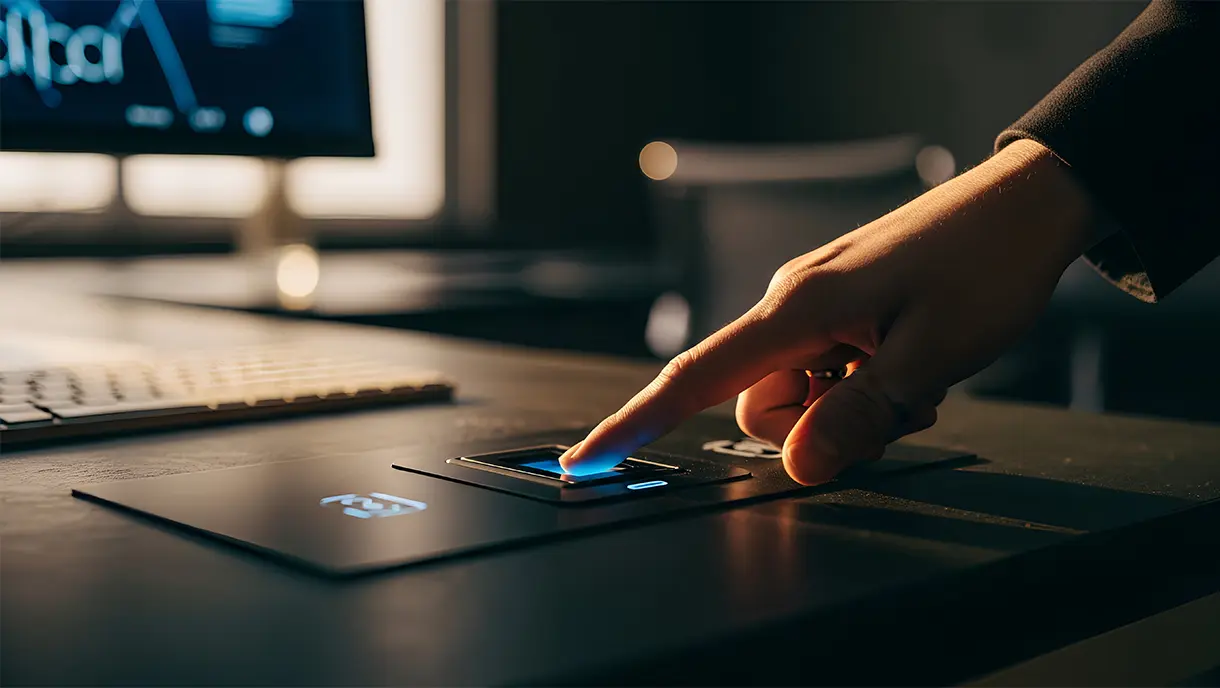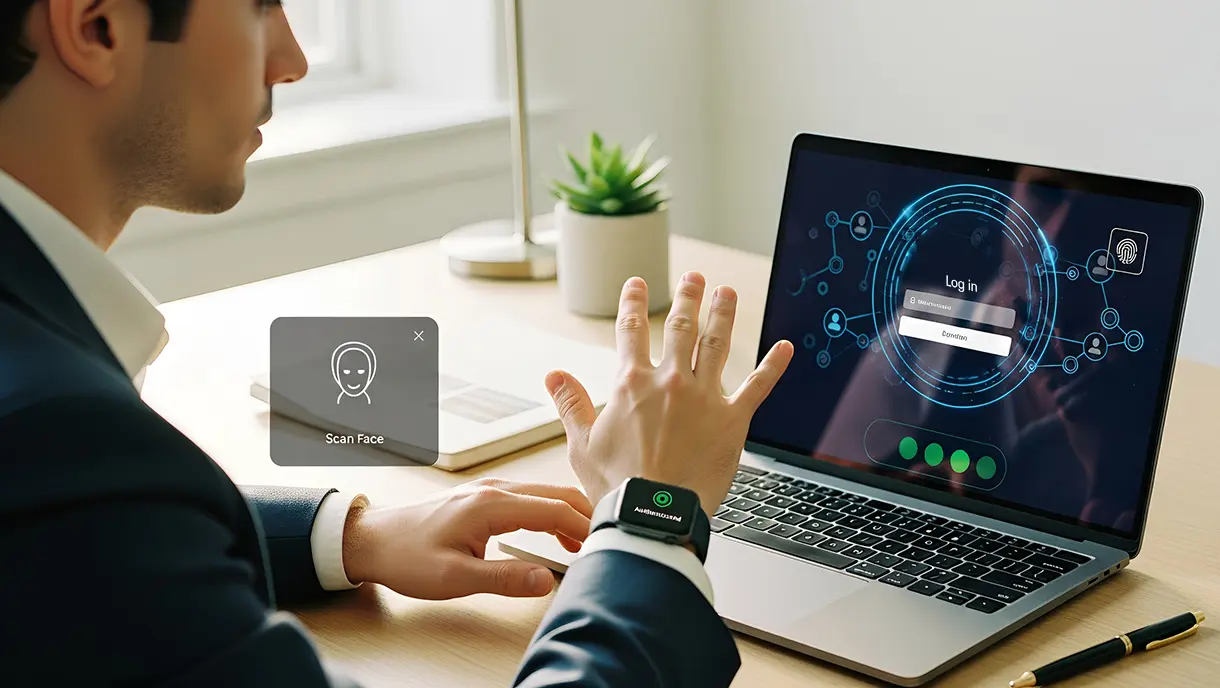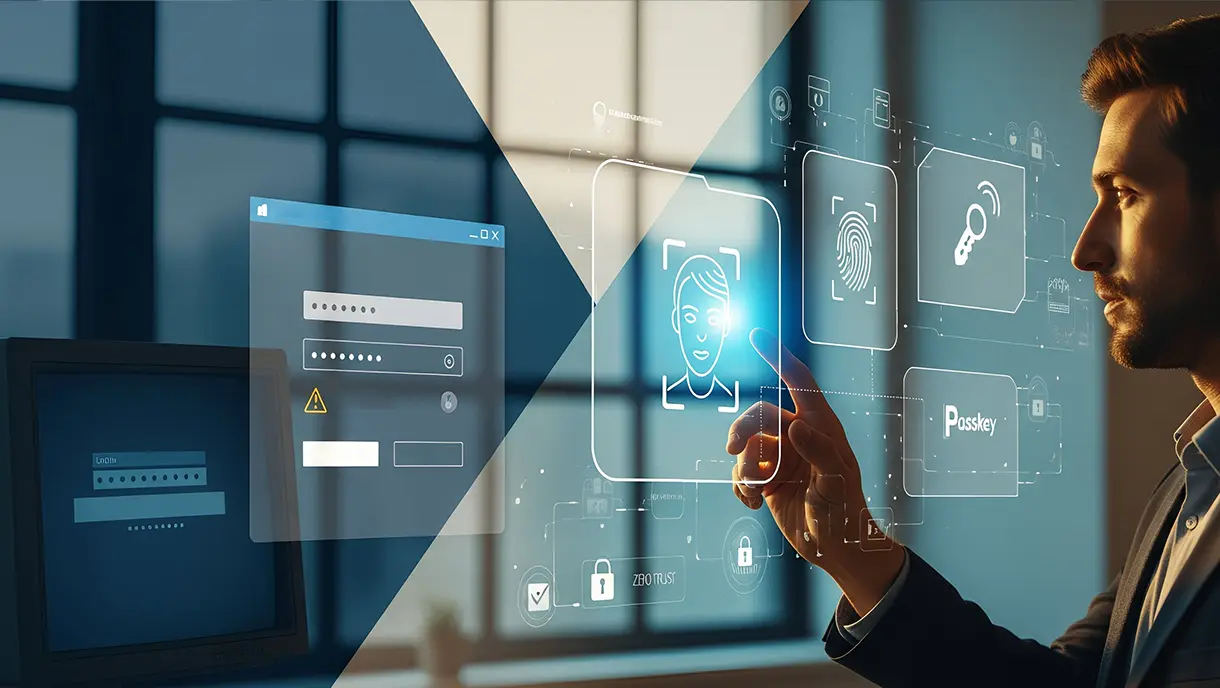What Is Biometric Authentication And How Does It Work?
Biometric authentication has transformed how organizations verify identity and secure access. This technology uses unique physical or behavioral traits like fingerprints, facial features, or voice patterns to replace vulnerable password-based systems. This guide covers the fundamentals of biometric authentication, including how the technology works and the various types available. You'll find practical implementation strategies, real-world industry applications, and key benefits for enterprises.

Passwords were once the cornerstone of digital security, but in today’s fast-moving, interconnected world, they’ve become one of its most significant weaknesses. From phishing attacks to password fatigue and compliance risks, traditional credentials can no longer keep up with the complexity of modern enterprise environments.
That’s where biometric authentication comes in. By verifying identity through something unique to each person, like fingerprints, facial patterns, or voice, biometrics offer a level of security that’s both reliable and user-friendly. It eliminates password hassles, reduces fraud, and delivers seamless access experiences across devices and locations.
For IT leaders and security professionals, biometric authentication isn’t just a technology upgrade; it’s a strategic move toward passwordless, frictionless identity management.
This guide explains how biometric authentication works, its key benefits, and real-world applications. Get actionable steps to adopt biometrics-based authentication in your organization.
What Is Biometric Authentication?
Biometric authentication is a security process that verifies a person’s identity based on their unique physical or behavioral traits. Instead of relying on something a user knows, like a password or PIN, it uses something they are, such as a fingerprint, facial pattern, iris scan, or voice.
This approach offers a more reliable and convenient method of access control for both individuals and organizations. By linking identity directly to biological characteristics, biometric authentication reduces the risks of stolen credentials, shared logins, or unauthorized access.
Enterprises today are adopting biometric authentication to strengthen security frameworks, improve workforce efficiency, and support passwordless environments. Whether used to unlock devices, verify workforce attendance, or control facility access, biometrics deliver fast, secure, and user-centric identity validation.
Key Characteristics Of Biometric Authentication
Biometric authentication distinguishes itself through several fundamental characteristics that make it superior to traditional methods. These attributes work together to create a robust security framework.
- Uniqueness and Accuracy of Identification: Each person’s biometric traits, from fingerprints to facial geometry, are inherently unique, enabling highly accurate and individualized authentication.
- Real-Time Verification: Biometric systems capture and validate identity within seconds, allowing instant access to digital systems, applications, or physical spaces.
- Difficult to Forge or Share: Because biometric identifiers are tied to the individual, they can’t be stolen, guessed, or replicated easily, unlike passwords or access cards.
- Enhances both Security and Convenience: Users gain a seamless, password-free login experience, while organizations benefit from reduced fraud risks and stronger data protection.
With the basics of biometrics-based authentication covered, let’s see how this technology works to authenticate users.
How Biometric Authentication Works
Biometric authentication follows a systematic process to capture, convert, and verify identity information. The technology combines hardware sensors, encryption algorithms, and pattern-matching software.
Step 1: Capture Unique Biometric Data
The authentication process begins when specialized sensors capture distinctive biological or behavioral traits. Fingerprint scanners use optical or capacitive technology to record ridge patterns on fingertips.
Facial recognition cameras capture geometric measurements and unique facial landmarks. Iris scanners photograph intricate patterns in the colored part of the eye. Voice recognition systems record audio samples and analyze vocal characteristics to identify and recognize speech.
Key Aspects of Biometric Data Capture
- High-resolution sensors that capture detailed biometric information with precision.
- Multiple data points are collected simultaneously to improve accuracy and prevent spoofing.
- Environmental adaptation that adjusts for lighting conditions, distances, and background noise.
- Liveness detection, which verifies that the biometric sample originates from a living person.
Step 2: Convert Raw Data Into Digital Templates
Once captured, the system converts raw biometric data into encrypted mathematical representations, known as templates. Sophisticated algorithms extract distinctive features from the captured biometric sample.
The system converts these features into numerical values that represent unique patterns. This conversion ensures that original biometric images or recordings are never stored directly.
Template Creation Process
- Feature extraction that identifies and isolates unique characteristics from biometric data.
- Data normalization that standardizes measurements regardless of capture conditions.
- Template compression that creates compact representations for efficient storage and comparison.
- A one-way transformation that renders it impossible to reconstruct the original biometric data from the templates.
Step 3: Encrypt And Store Biometric Templates Securely
The system encrypts biometric templates using advanced cryptographic methods before storage. Templates may be stored locally on user devices, such as smartphones or smart cards.
Alternatively, they can be stored in secure databases with enterprise-grade encryption. This approach protects sensitive biometric information from unauthorized access or data breaches.
Key Aspects of Secure Template Storage
- Local device storage that keeps templates on smartphones or security tokens for enhanced privacy.
- Encrypted databases that protect templates using AES-256 or similar enterprise-grade encryption.
- Separated encryption keys that are managed independently from template storage locations.
- Access controls that restrict who can view, modify, or delete stored biometric templates.
Step 4: Match Live Input With Stored Templates
During authentication, the system captures a fresh biometric sample from the user. Advanced algorithms convert this live sample into a new template using the same process.
The system then compares the live template against stored templates in the database. Pattern-matching algorithms calculate similarity scores to determine if the samples match within acceptable thresholds.
The Matching Process
- Similarity scoring that calculates how closely live and stored templates align.
- Threshold adjustment that balances security requirements with user convenience.
- Multi-factor comparison that may combine multiple biometric modalities for enhanced security.
- Fraud detection that identifies potential spoofing attempts or anomalous authentication patterns.
Step 5: Verify Identity And Grant Access
The system validates user identity within milliseconds after comparing biometric templates. If the similarity score exceeds the predetermined threshold, authentication succeeds. The system grants access to requested resources, applications, or physical locations.
If the match fails, the system denies access and may log the failed attempt for security monitoring.
Final Verification Factors
- Access decision logic that determines whether to grant or deny entry based on match results.
- Audit logging that records all authentication attempts for compliance and security analysis.
- Fallback mechanisms that provide alternative authentication methods when biometric verification fails.
- Integration triggers that activate downstream systems, such as physical access controllers or application servers.
Types of Biometric Authentication
Biometric authentication technologies can be categorized into two main groups based on the characteristics they measure. Organizations often combine multiple biometric access control methods to create layered security.
1. Physiological Biometrics
Physiological biometric systems measure physical characteristics of the human body. These traits are unique to each individual and change minimally over time. Physical biometrics offer high accuracy and are widely deployed across various applications. They provide reliable identification even in challenging environmental conditions.
1.1 Fingerprint Recognition
Fingerprint recognition analyzes the unique ridge patterns, whorls, and minutiae points on fingertips. This technology has been utilized for decades in law enforcement and is now widely incorporated into consumer devices. Modern fingerprint sensors can detect fake fingerprints and require living tissue for authentication.
1.2 Facial Recognition
Facial recognition technology maps distinctive facial features, including the distance between the eyes, the shape of the nose, and the contours of the jawline. Advanced systems use 3D mapping and infrared imaging to prevent spoofing with photographs. This biometric modality enables contactless authentication from a distance.
1.3 Iris and Retina Scanning
Iris scanning photographs the colored ring around the pupil, capturing intricate patterns visible even through contact lenses. Retina scanning analyzes blood vessel patterns at the back of the eye using infrared light. Both methods offer exceptionally high accuracy but require specialized equipment.
1.4 Palm Vein or Hand Geometry
Palm vein recognition uses near-infrared light to capture vein patterns beneath the skin. Hand geometry systems measure the shape, size, and proportions of hands and fingers. These methods are well-suited for industrial environments and are resistant to dirt and surface damage.
2. Behavioral Biometrics
Behavioral biometric systems analyze patterns in human behavior. These characteristics are learned over time and can adapt to changes in user behavior. Behavioral biometrics often work continuously in the background, providing ongoing authentication.
2.1 Voice Recognition
Voice recognition analyzes vocal characteristics, including pitch, tone, cadence, and accent patterns. The technology examines both physiological aspects of the vocal tract and behavioral speech patterns. Modern systems can distinguish between recorded voices and live speakers.
2.2 Typing Rhythm
Typing rhythm biometrics analyzes how individuals type on keyboards, including keystroke timing and pressure patterns. The system learns unique typing behaviors, including dwell time, flight time, and typing speed. This continuous authentication method works silently in the background.
2.3 Gait and Movement Patterns
Gait recognition analyzes how individuals walk, including stride length, walking speed, and body movement. The technology uses video cameras or motion sensors to capture distinctive movement patterns. Some systems analyze how users hold and interact with mobile devices.
Now that we’ve explored the different types of biometric authentication, let’s look at how this technology benefits organizations by strengthening security and improving user experience.
[[cta]]
6 Noteworthy Benefits of Biometric Authentication for Businesses
As businesses continue to balance security, convenience, and user experience, biometric authentication has emerged as a powerful solution that checks all three boxes. Let’s look at some of the most impactful benefits of biometric authentication for modern enterprises.
1. Strengthens Security with Non-Replicable Identities
Biometric authentication eliminates vulnerabilities associated with passwords, tokens, and other traditional forms of identification. Physical and behavioral characteristics cannot be guessed, stolen, or shared like conventional authentication methods.
This fundamental security advantage reduces the risks posed by phishing, credential stuffing, and social engineering. Businesses experience fewer security incidents and data breaches when properly implementing biometric systems.
2. Eliminates Password Fatigue and Streamlines User Experience
Users no longer need to remember multiple complex passwords or undergo frequent password resets. Biometric authentication provides instant access with a simple fingerprint scan, facial recognition, or voice command.
The convenience of instant access enhances user satisfaction, especially in frontline industries. Such industries use a facial authentication platform to seamlessly authenticate workers using facial biometrics. Employees spend less time on login procedures and more time on valuable work activities.
3. Accelerates Compliance with Data Privacy Regulations
Modern biometric systems incorporate privacy-by-design principles that align with the GDPR, HIPAA, CCPA, and other relevant regulations. Encrypted biometric templates cannot be reverse-engineered to recreate original biometric data.
Organizations maintain detailed audit trails that show consent, data usage, and access patterns, which are required for compliance reporting. Implementing compliant biometric authentication demonstrates a commitment to protecting sensitive personal information.
4. Minimizes IT Costs by Reducing Password Management
Password resets and helpdesk requests consume significant IT resources in traditional authentication environments. Biometric authentication eliminates these recurring costs by removing passwords from the authentication equation.
IT teams redirect time and budget toward strategic initiatives rather than routine password support. Organizations typically see ROI within months through reduced helpdesk tickets and administrative overhead.
5. Enhances Workforce Productivity and Trust
Fast, reliable biometric authentication removes barriers that slow down workforce activities throughout the day. Employees access multiple systems, applications, and physical spaces without interruption or authentication delays.
This seamless experience builds trust in security systems and reduces the need for workarounds that compromise security. Productivity gains compound across the organization as authentication friction disappears.
6. Enables Passwordless, Future-Ready Authentication Systems
Biometric authentication serves as the foundation for modern identity frameworks supporting zero-trust architectures. The technology integrates seamlessly with multi-factor authentication, single sign-on, and adaptive access policies.
Organizations position themselves for future security requirements by adopting standards-based biometric solutions today. This forward-looking approach ensures the authentication infrastructure remains relevant as security threats evolve.
While these benefits make a strong case for adopting biometric authentication, their true value becomes evident when applied in real-world scenarios. Let’s explore some of the most common and impactful use cases across industries.
[[cta-2]]
Use Cases Of Biometric Authentication Across Industries
Biometric authentication solves real-world security and efficiency challenges across diverse industries and applications. Organizations deploy these systems to protect physical assets, secure digital resources, and verify identities at critical points of interaction.
1. Enterprise Access Control
Organizations use biometric authentication to secure both physical facilities and digital resources through unified identity management. Employees access office buildings, data centers, and restricted areas using fingerprint or facial recognition.
The same biometric credentials authenticate users to computers, applications, and cloud services. This convergence of physical and logical access control simplifies administration while strengthening security.
Common enterprise access control applications include:
- Building entry systems: Replace key cards with fingerprint or facial recognition for frictionless facility access.
- Workstation login: Enable fast, secure authentication to desktops and laptops without passwords.
- Time and attendance tracking: Eliminate buddy punching and accurately record employee work hours.
- Secure area access: Restrict entry to sensitive locations, such as server rooms or executive offices.
2. Financial Services
Banks and financial institutions deploy biometric authentication to prevent fraud while delivering convenient customer experiences. Mobile banking applications utilize fingerprint and facial recognition technology to verify account holders before processing transactions.
Voice biometrics authenticates customers calling into contact centers without knowledge-based questions. These implementations reduce fraud losses while improving customer satisfaction.
Key financial services implementations include:
- Mobile banking authentication: Secure app access and transaction approval with built-in device biometrics.
- ATM cardless withdrawal: Enable customers to withdraw cash using facial or palm vein recognition.
- Branch customer verification: Speed up in-person transactions by eliminating manual ID checks.
- Payment authorization: Confirm high-value transactions using biometric verification for added security.
3. Healthcare
The healthcare industry uses biometric authentication to protect patient records while ensuring accurate patient identification. Hospital staff access electronic health records using fingerprint or iris scanning to maintain HIPAA compliance.
Biometric patient identification prevents medical errors due to misidentification at admission or during treatment. This technology safeguards sensitive health information while improving care quality.
Healthcare biometric applications include:
- Patient identification: Accurately match patients with their medical records to prevent dangerous identification errors.
- Prescription access control: Restrict controlled substance dispensing to authorized personnel only.
- Medical record security: Ensure only authorized providers have access to sensitive patient information.
- Newborn identification: Use footprint or palm print biometrics to prevent infant abduction.
4. Manufacturing and Logistics
Manufacturing facilities utilize biometric systems to verify employee identity, monitor attendance, and regulate access to production areas. Employees authenticate quickly, even when wearing gloves or in harsh environmental conditions.
Biometric time clocks eliminate time theft and provide accurate labor cost tracking. These systems integrate with existing HR and production management platforms.
Manufacturing and logistics use cases include:
- Workforce verification: Confirm employee identity at shift changes and access points for production lines.
- Equipment access control: Restrict the operation of dangerous machinery to authorized, trained personnel.
- Supply chain security: Verify driver identity at loading docks and distribution centers to ensure secure operations.
- Quality control tracking: Link production activities to specific workers for accountability.
As these use cases show, biometric authentication is reshaping identity verification across industries. The next step for organizations is to understand how to implement it effectively while balancing security, compliance, and user experience.
How To Implement Biometric Authentication In Your Organization
Successful biometric authentication implementation requires careful planning, effective stakeholder engagement, and a phased deployment approach. Following a structured implementation approach increases adoption rates and delivers measurable business value.
Step 1: Assess Your Security Goals and Use Cases
- Begin by identifying specific security challenges and authentication pain points within your organization.
- Determine whether you need biometric authentication for workforce access, customer-facing applications, or both.
- Prioritize use cases that deliver the highest security value and return on investment.
- Engage stakeholders from IT, security, HR, and business units to gain a comprehensive understanding of the requirements.
Step 2: Choose the Right Biometric Modalities for Your Needs
- Select biometric technologies that match your environment, user population, and security requirements.
- Consider factors such as accuracy requirements, user acceptance, hygiene concerns, and existing device capabilities.
- Fingerprint recognition works well in controlled office environments, while facial recognition is better suited for contactless applications.
Step 3: Evaluate Compliance and Data Privacy Requirements
- Research regulations governing biometric data collection, storage, and usage in your jurisdictions.
- Ensure your implementation includes proper consent mechanisms, data minimization practices, and user rights management.
- Document privacy impact assessments and data processing agreements as required by GDPR, CCPA, or industry-specific regulations.
- Engage legal counsel to review compliance aspects before deployment.
Step 4: Select a Trusted Biometric Authentication Platform
- Evaluate vendors based on security certifications, scalability, integration capabilities, and long-term viability.
- Look for platforms that support industry standards, such as FIDO2, W3C WebAuthn, and relevant biometric data protection specifications.
- Ensure the solution integrates with your existing identity and access management infrastructure without requiring a complete system replacement.
Step 5: Integrate Biometric Authentication with Existing Systems
- Collaborate with your chosen vendor to integrate biometric authentication with HR systems, directory services, and access control platforms.
- Leverage APIs, SDKs, or pre-built connectors to streamline integration and reduce custom development.
- Test integrations thoroughly to ensure seamless operation across your technology stack.
- Plan for graceful fallback mechanisms when biometric authentication fails or is unavailable.
Step 6: Pilot the Solution and Optimize Performance
- Deploy biometric authentication to a limited user group in a controlled environment before rolling it out fully.
- Collect feedback on user experience, authentication speed, and error rates during the pilot phase.
- Monitor system performance metrics and adjust thresholds or configurations to optimize accuracy and performance.
- Use pilot insights to refine training materials and deployment procedures.
Step 7: Train Employees and Build Awareness
- Develop comprehensive training programs explaining how biometric systems work and why they benefit users.
- Address common concerns about privacy, data security, and what happens if biometric authentication fails.
- Create clear documentation and support resources that users can reference after initial training.
- Emphasize that biometric data is encrypted and cannot be used to recreate original biometric characteristics.
Step 8: Monitor Performance and Maintain Security Posture
- Establish ongoing monitoring for authentication success rates, system uptime, and security events.
- Review audit logs regularly to identify anomalies or potential security incidents.
- Keep biometric software and firmware up to date with the latest security patches and feature enhancements.
- Conduct periodic assessments to ensure the system continues meeting security and compliance requirements.
[[cta-3]]
Secure Every Access Point With OLOID’s Biometric Authentication
Biometric authentication is the future of identity security by combining unmatched security with exceptional user convenience. Organizations no longer need to choose between robust security controls and a positive user experience.
OLOID’s frontline passwordless authentication platform bridges the gap between digital and physical access systems with powerful facial authentication biometrics. With OLOID, employees can move effortlessly from logging into applications to unlocking doors, all through a single, trusted identity.
Built with enterprise-grade encryption and consent-based data handling, OLOID ensures every authentication is private, compliant, and protected. Our platform adheres to the highest security standards and privacy regulations, giving your organization the confidence to scale securely.
Ready to transform your organization's authentication experience with secure, passwordless biometric solutions? Book a demo today and discover how OLOID can strengthen your security posture while delighting your users.
Frequently Asked Questions on Biometric Authentication
1. What are the main types of biometric authentication?
Biometric authentication includes physiological and behavioral types that verify identity through unique human characteristics.
- Physiological biometrics: Fingerprint, facial recognition, iris scanning, retina scanning, palm vein, hand geometry
- Behavioral biometrics: Voice recognition, typing rhythm, gait analysis, signature dynamics
Modern biometric authentication systems employ a multimodal approach that enhances accuracy, strengthens security, and creates a layered defense, balancing convenience with robust protection against unauthorized access.
2. What are the common limitations of biometric authentication?
While highly effective, biometric authentication faces certain challenges that organizations should consider during implementation.
- Initial setup costs: Hardware sensors and software infrastructure require upfront investment.
- Privacy concerns: Users may worry about biometric data collection and storage practices.
- Environmental factors: Lighting, noise, or physical conditions can impact authentication accuracy.
- Accessibility issues: Some users are unable to provide certain biometric types due to disabilities or injuries.
- False rejections: Legitimate users may occasionally be denied access, requiring fallback authentication.
3. Is biometric authentication more secure than passwords?
Biometric authentication offers significantly stronger security than password-based systems for several reasons. Biometric characteristics cannot be guessed, stolen through phishing, or shared between users like passwords.
The technology provides non-repudiation, as individuals cannot deny their presence during biometric authentication. However, organizations achieve maximum security by combining biometric authentication with other factors in multi-factor authentication frameworks rather than relying on a single method.
4. Can biometric authentication be hacked?
While no security system is entirely immune to attacks, modern biometric authentication is extremely difficult to compromise. Sophisticated systems include liveness detection that prevents spoofing with photographs, masks, or recordings.
Biometric templates are encrypted and cannot be reverse-engineered to recreate original biometric data. The primary vulnerabilities exist in implementation weaknesses rather than the biometric technology itself. Organizations minimize risks by selecting certified solutions, adhering to security best practices, and maintaining up-to-date systems.
5. What are the challenges of implementing biometric authentication?
Organizations face several implementation challenges that require careful planning and management.
- Change management: Overcoming user resistance and building trust in new authentication methods.
- Technical integration: Connecting biometric systems with existing IAM and access control infrastructure.
- Scalability planning: Ensuring systems handle growing user populations and authentication volumes.
- Regulatory compliance: Navigating complex privacy laws across different jurisdictions and industries.
Cost justification: Demonstrating ROI and security value to secure necessary budgets.
Get the latest updates! Subscribe now!







